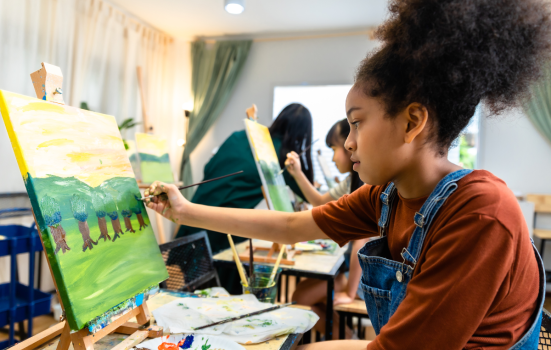Ofsted Chief Inspector says the government body recognises the values of arts education, as report underlines decline in provision and guidance for teachers.

anon-tae via iStock
Art and design education should command an important place in every school, according to a report from education inspectors Ofsted.
The Curriculum Review for Art & Design is the eleventh subject area review published by Ofsted. It details the current provision of arts and design subjects in schools and set outs principles for teaching a high quality arts and design curriculum.
Speaking at the launch of the review in February, Ofsted Chief Inspector Amanda Spielman said “setting art alongside other subjects in this series shows how we are recognising its value, and makes it clear that art does not sit beneath or apart from the rest of the curriculum.”
READ MORE:
“Of course, there are practical constraints. We know how hard-pressed schools are, and that there is less taught time for art and design,” Spielman added.
“But I take heart from the fact that exam entries have held more or less steady through all the changes of the past 20 years, showing that young people’s willingness and interest is not eroding.”
The report says fears that not enough time is given to arts and design subjects are “not unwarranted” and notes a decline in the quantity and quality of arts education across age groups.
The decrease in provision of arts curriculum in Early Years Foundation Stage and Primary Schools is attributed to primary school teachers often having low confidence around teaching art, a lack of subject knowledge or focus, and a decline in funding.
The report also notes that the last decade witnessed a decline in the number of specialist art and design teachers and the number of hours pupils are taught art in secondary schools.
In response, Ofsted says adequate time should be given to arts education, particularly in Key State 3: “An art curriculum that significantly limits the amount of time given to the subject is unlikely to benefit pupils.”
It adds it is the responsibility of school leaders to ensure sufficient time is attributed to arts subjects and arts and design teachers are given time and support to develop their subject and pedagogical content knowledge.
It warns against removing art from the timetabled curriculum and offering it only as an extra-curricular activity, stating that “does not give all pupils an equal opportunity” and says ‘lumping’ art and design subjects with others on a carousel is a “risk”.
Guidance for teachers
Ofsted’s review highlights that the national curriculum does not set out a mandatory arts curriculum, leaving schools to decide the breadth, depth and sequence of which arts subjects are taught in.
It states the art and design curriculum should be ambitious for all pupils, and expectations for pupils with special educational needs should not be lowered, reccomending parts are adapted rather than removed.
Just three areas of making – drawing, painting and sculpture – are specified in the national curriculum, but Ofsted’s report highlights a further nine that could be studied: printmaking, ceramics, creative craft, collage, textiles, photography and lens-based media, installation and site-specific work, digital and new media, design and graphic design.
The review urges school leaders to hone in on certain areas of making, stating that there is not enough capacity to cover all areas meaningfully: “Pupils will not be able to engage meaningfully in each tradition if the curriculum is ‘a mile wide and an inch deep’”.
General Secretary and CEO of the National Society for Education in Art & Design (NSEAD), Michele Gregson, agrees that a mile wide and inch deep approach does not serve learners, but added that “decisions about content and breadth of coverage should not be driven by lack of curriculum time and limited resources”.
“High-quality education requires adequate investment,” Gregson said.
“Encouragingly, Ofsted says that art should command an important place in every school. NSEAD would of course go further – we believe that art and craft and design must have an important place in every school.”
Limiting approach
Sections of Ofsted’s review focus on the scientific theory behind developing knowledge and skills in arts education, something which both Gregson and AccessArt CEO and Creative Director Paula Briggs told Arts Professional could limit practical application for teachers.
“We find this to be a limiting feature of the report. It is true that art, craft, and design education involves the acquisition of knowledge and development of skills, but it is also about experience and expression, creativity and culture, risk, identity, and values,” Gregson said.
“AccessArt welcomed the rigour of approach implied by the review, and the emphasis on art as a vital subject, but we were less clear however how the non-specialist teacher is expected to understand or act upon the guidance,” Briggs said.
“The gap between an outdated national curriculum document and the expectations exerted by Ofsted continues to grow, leaving teachers in an often fearful and panicked position.”
“We'd urge teachers not to use the review as a way of trying to create an excellent art education for their pupils, and instead make use of the expertise out there - subject associations such as AccessArt and NSEAD, as well as the wealth of experience in freelance art education consultants and work together to create a better understanding of what excellent and ambitious practice might look like in your school.”




